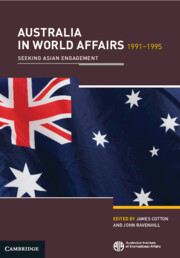Book contents
- Frontmatter
- Contents
- Tables
- Abbreviations
- Contributors
- Preface
- 1 Australia’s ‘Engagement with Asia’
- 2 An Overview
- 3 The Rhetoric of Asia
- 4 Australia and Asia: A View From Europe
- 5 Australia’s Defence Policies in the Post–Cold War Era
- 6 Australia, Disarmament and Arms Control
- 7 Australia and the World Economy 1991–95: Closer Economic Integration with Asia?
- 8 Australia and the International Environment
- 9 Australia and Japan
- 10 Australia and Southeast Asia
- 11 Australia and China, 1991–95: Asymmetry and Congruence in the Post–Cold War Era
- 12 Australia and the Four Asian Dragons: Beyond the Economic Agenda?
- 13 Reassessed: Australia’s Relationship with the United States
- 14 Australia and the European Union
- 15 Australian Relations with the Former Communist States of Europe and the Soviet Union
- 16 Australia and New Zealand: Unequal Partners on the Periphery
- 17 Australia and the South Pacific: The Rationalist Ascendancy
- Notes
- Index
1 - Australia’s ‘Engagement with Asia’
Published online by Cambridge University Press: 04 May 2024
- Frontmatter
- Contents
- Tables
- Abbreviations
- Contributors
- Preface
- 1 Australia’s ‘Engagement with Asia’
- 2 An Overview
- 3 The Rhetoric of Asia
- 4 Australia and Asia: A View From Europe
- 5 Australia’s Defence Policies in the Post–Cold War Era
- 6 Australia, Disarmament and Arms Control
- 7 Australia and the World Economy 1991–95: Closer Economic Integration with Asia?
- 8 Australia and the International Environment
- 9 Australia and Japan
- 10 Australia and Southeast Asia
- 11 Australia and China, 1991–95: Asymmetry and Congruence in the Post–Cold War Era
- 12 Australia and the Four Asian Dragons: Beyond the Economic Agenda?
- 13 Reassessed: Australia’s Relationship with the United States
- 14 Australia and the European Union
- 15 Australian Relations with the Former Communist States of Europe and the Soviet Union
- 16 Australia and New Zealand: Unequal Partners on the Periphery
- 17 Australia and the South Pacific: The Rationalist Ascendancy
- Notes
- Index
Summary
The extent to which Australian foreign policy was reoriented between 1991 and 1995 is evident from an examination of the last edition of Australia in World Affairs. In the 1980s, the Soviet Union still loomed large in world affairs; the alliance with the United States correspondingly remained central to Australian foreign policy. Efforts by the Hawke Government to engage more closely with Asia in these years had frequently been rebuffed, so that Fedor Mediansky was able to write at the end of the decade not of closer engagement with the region, but of ’Australia’s diminished regional standing’. Australia’s ’shift towards Asia’ gathered momentum in the first half of the 1990s. Some important foundations for this trend were laid in the later 1980s, especially in immigration patterns, trade and tourism. The desirability of this shift was articulated in a range of official reports and statements, including the Fitzgerald Report on immigration, the Garnaut Report on Australia’s relations with Northeast Asia, and the Foreign Minister’s statement Australia’s Regional Security, all produced before the collapse of the Soviet Union and the definitive ending of the Cold War.
Keywords
- Type
- Chapter
- Information
- Australia in World Affairs 1991–1995Seeking Asian Engagement, pp. 1 - 11Publisher: Cambridge University PressFirst published in: 2024



